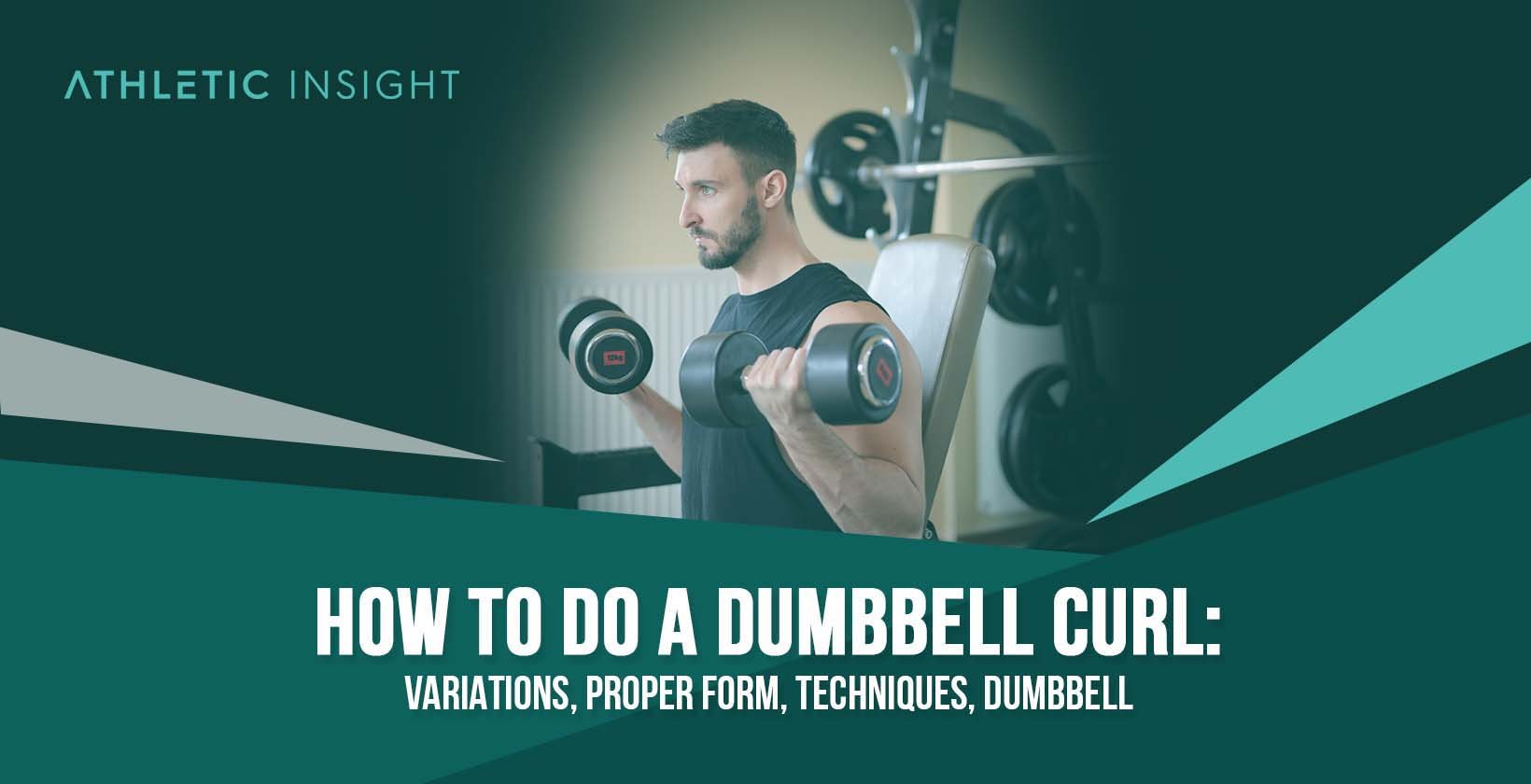Dumbbell curls are bicep curls that specifically use dumbbells. These exercises specifically work the biceps brachii. They improve muscle strength, add definition to the arm, and increase upper body strength.
The biggest mistakes while dumbbell curls are not maintaining proper form with your palms facing outwards and using the wrong weight, either too much or too little. Using too much weight can risk pulling or tearing a muscle. Using too little weight won’t give you a proper workout.
There are several types of dumbbell curl techniques. Each of these techniques is a different variation that slighty alters the area of the bicep, and surrounding muscles, that are impacted.
Curls are a great mass builder for the biceps. Whether you use a dumbbell, barbell, pulley machine, or any other machinery capable of exercising the biceps in a similar way to the dumbbell curl, you’ll be able to add mass and definition to your biceps.
How To Perform Dumbbell Curl With Proper Form?
Dumbbell Curl is a biceps exercise that only requires grip strength and two dumbbells. Proper form refers to a motion that involves a complete range of motion and a proper posture.

To achieve proper form, stand tall, holding a dumbbell in each hand, arms at your side, and palms facing forward. Your feet should be shoulder-width apart. You’ll want to hold the dumbbells in an underhand grip, and then lift them from waist level to shoulder level.
For a more detailed idea of how to perform the exercise, check out each step below.
- Stand shoulder or hip-width apart, knees slightly bent
- Keep your head and neck in a neutral position
- Distribute your weight evenly and grab the floor with your feet
- Control your breathing
- Hold the dumbbells at your sides, palms forward
- Maintain a long arm with a small bend at the elbows
- Tighten your shoulders and hips while engaging your core
- Squeeze your biceps and begin to bend your elbows. You should also maintain your upper arms stationary
- Bend your elbows so that your lower arms come into touch with your upper arms
- Don’t touch the dumbbells to your shoulder and squeeze your biceps at the end of the exercise
1. Stand shoulder or hip-width apart, knees slightly bent
Stand shoulder or hip-width apart, knees slightly bent. In order to perform the exercise, you need a proper stance. Not only will this help engage and enhance the biceps, but it’ll also prevent injury.
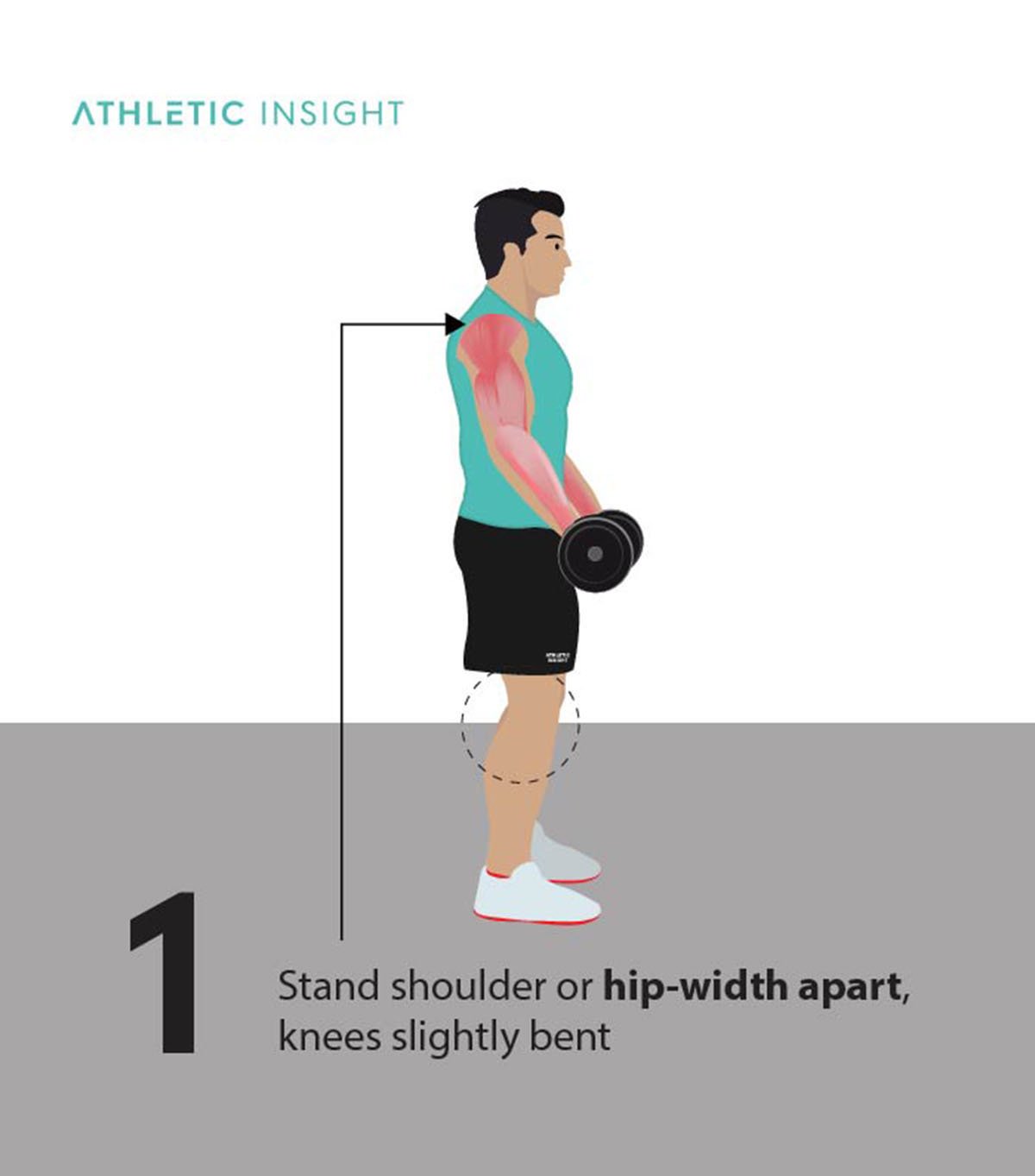
2. Keep your head and neck in a neutral position
Keep your head and neck in a neutral position. Many weightlifters incorrectly bring the head and neck forward which may cause serious injuries. While the incorrect forward head posture may be a result of lifestyle and not done on purpose, actively trying to maintain a neutral position will help during the lift.
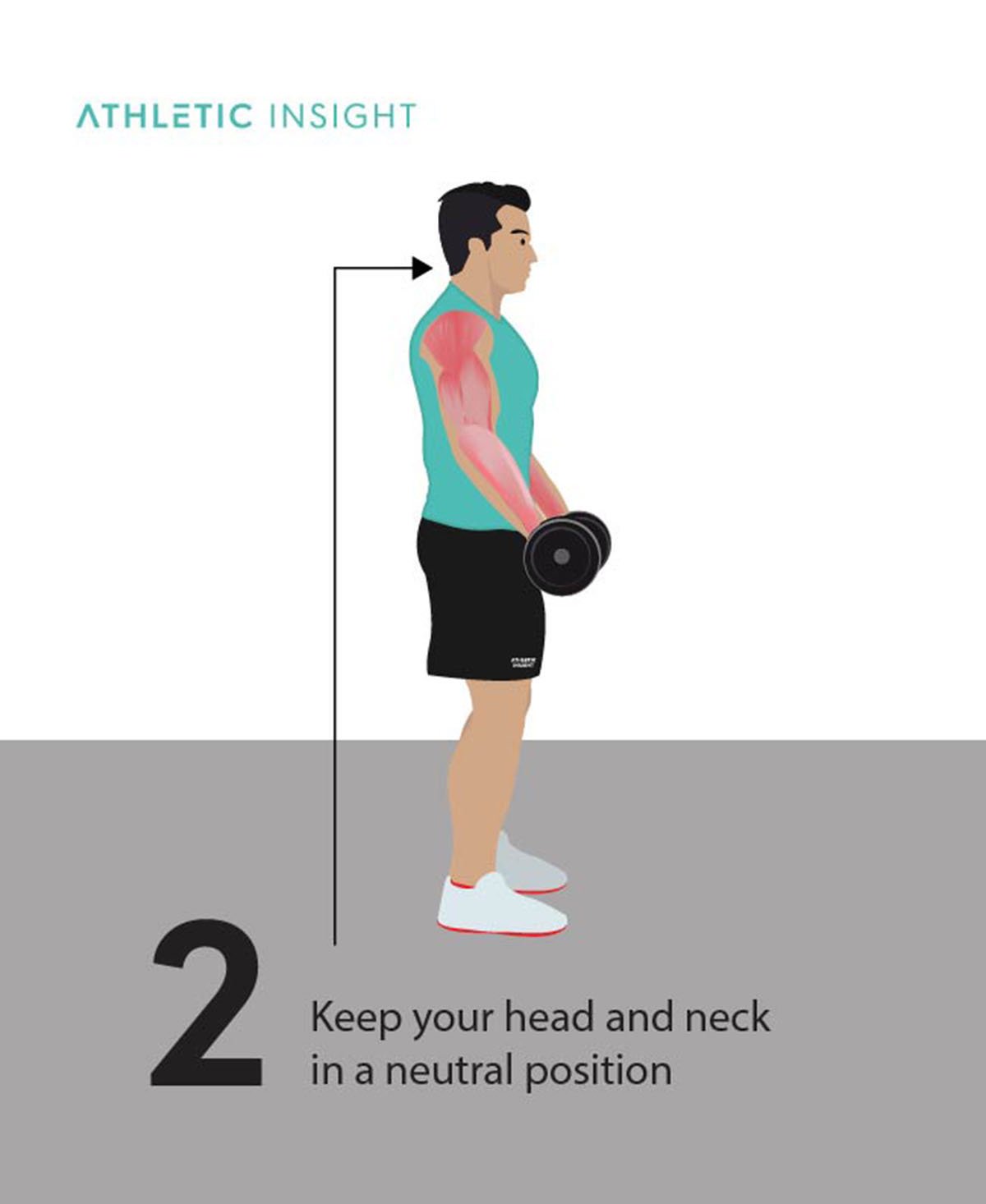
3. Distribute your weight evenly
Distribute your weight evenly to avoid improper form or injury. Whether due to injury or a muscular imbalance, many people tend to favor one side over the other. It is crucial to be hyper-aware of this and maintain a well-balanced stance with your weight evenly spread.
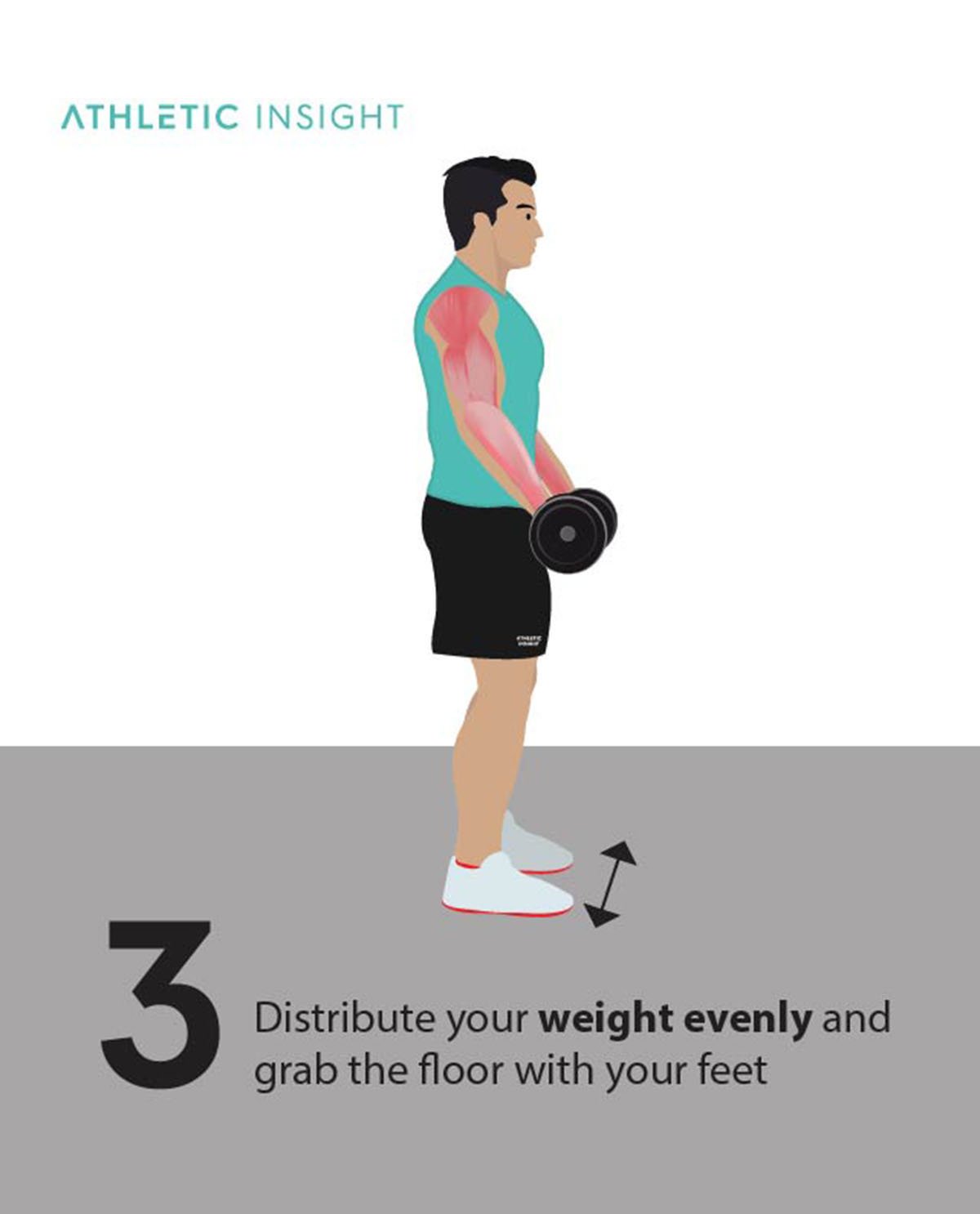
4. Control your breathing
Control your breathing. Before beginning the concentric portion of the lift, you’ll want to take a deep breathe in while bracing your core (diaphragmatic breathing). Once the exercise begins, you’ll slowly breathe outwards while deflating your stomach. Throughout the exercise, the core will remain tight.
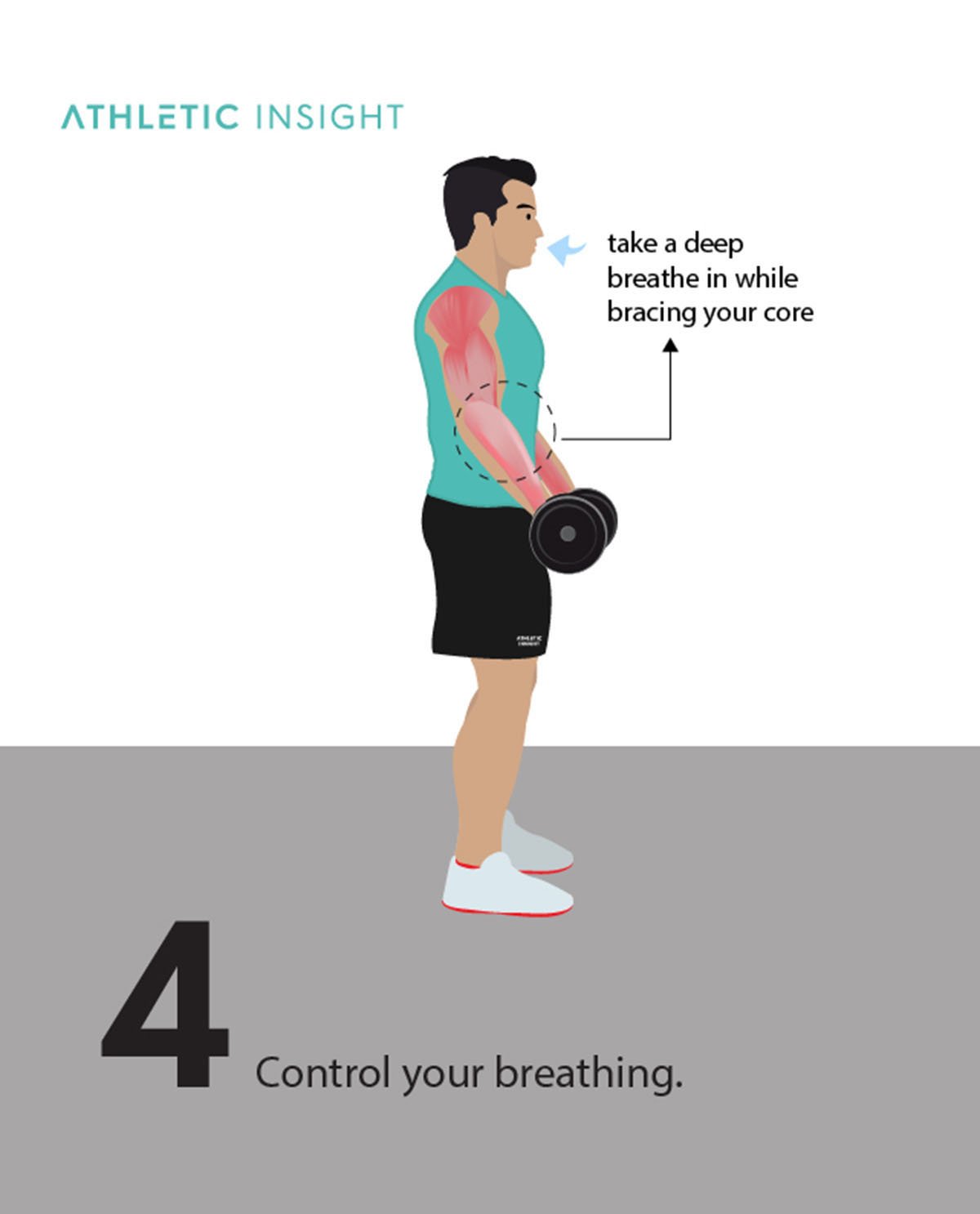
5. Hold the dumbbells at your sides, palms forward
Hold the dumbbells at your sides, palms forward. If you wish to perform a variation of the dumbbell curl, you can position your hands in different ways (such as the reverse grip dumbbell curl). For a standard dumbbell curl, keep the palms facing upwards.
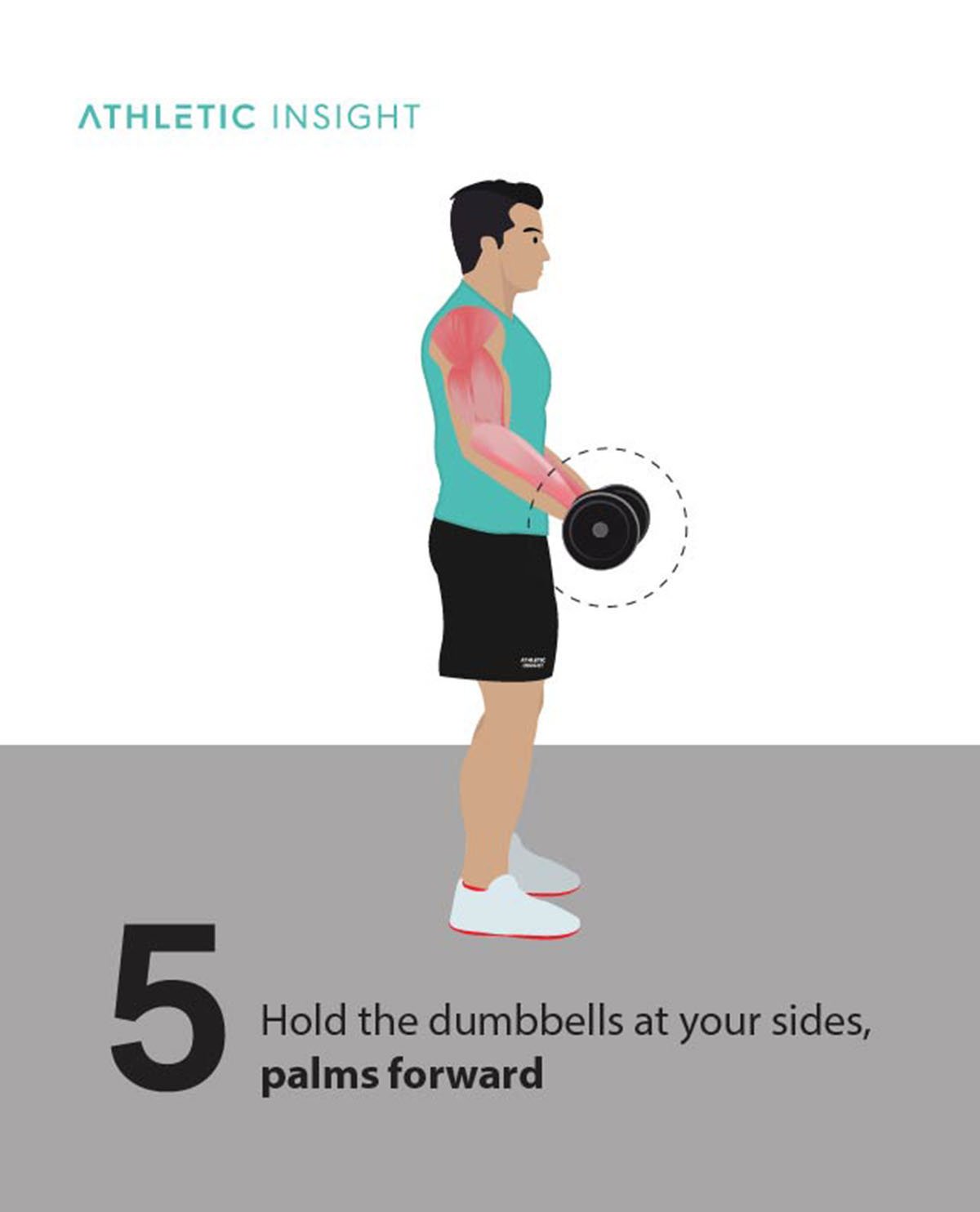
6. Maintain a long arm with a small bend at the elbows
Maintain a long arm with a small bend at the elbows. If you find that the weight is too heavy and your arms have a difficult time maintaining this position, then you are using too much weight. You should be able to hold the weight out in front of you without your arm giving out and bending straight. Maintaining this position helps to prevent hyper-extensions and other serious joint and tendon injuries.
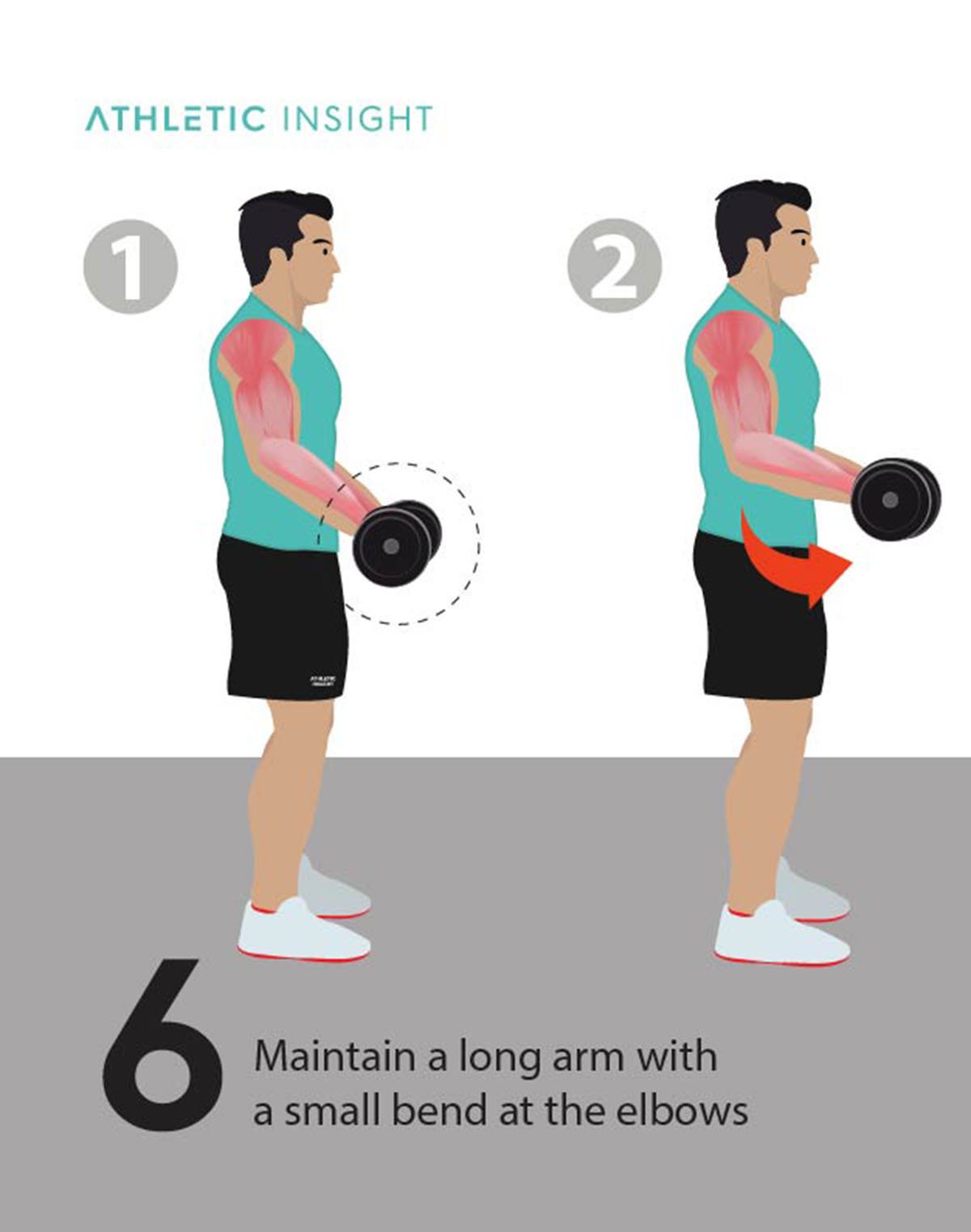
7. Tighten your shoulders and hips while engaging your core
Tighten your shoulders and hips while engaging your core. Similarly to your core and biceps, you’ll want your shoulders to be tight and you’ll want to slightly drive with your hips. While the focus is on the biceps, having slight hip drive will help to get the kinetic energy flowing from your hips, to your biceps. If you wish to only isolate the biceps, then you should avoid the dumbbell curl and focus more on isolated bicep curls.
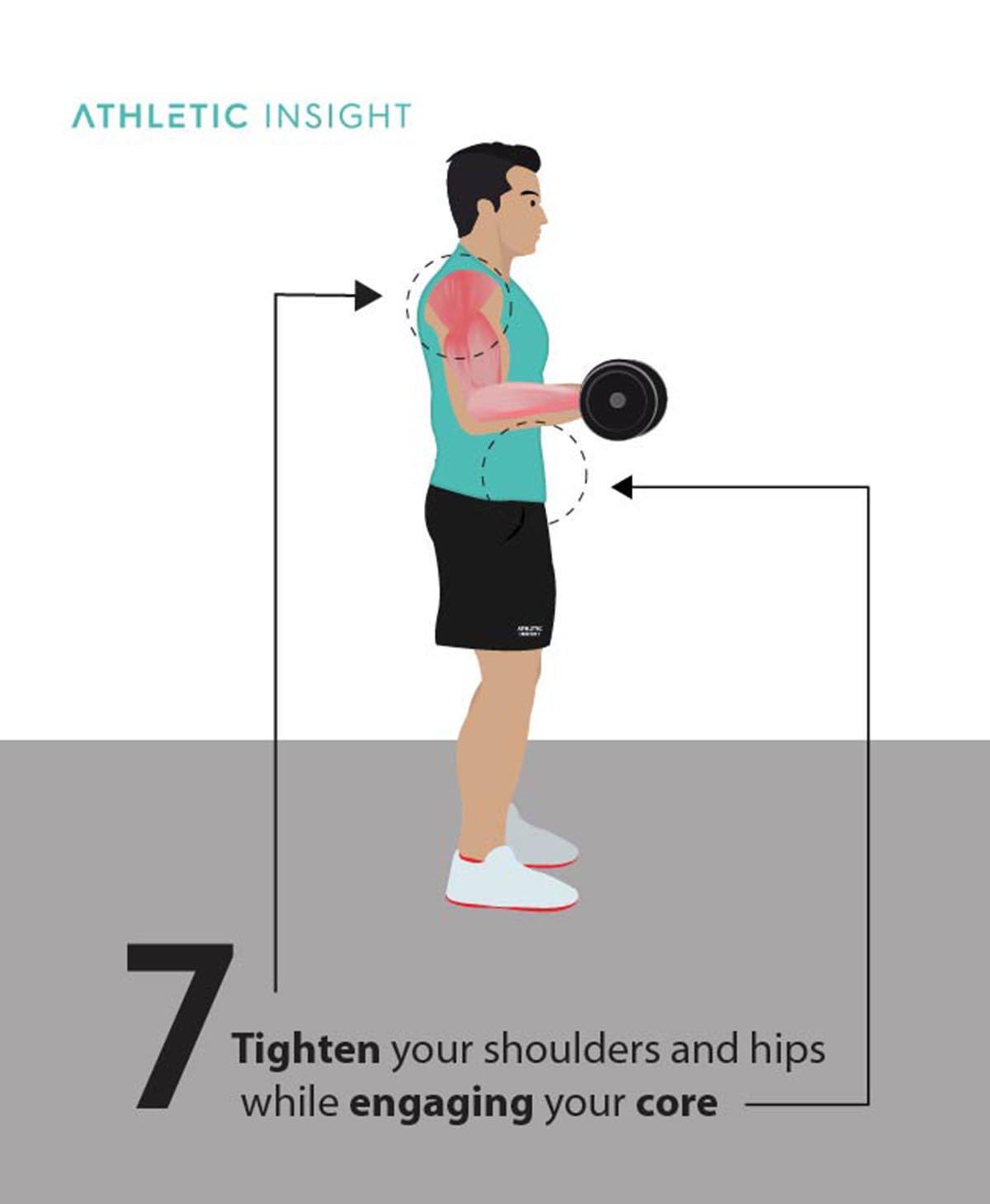
8. Squeeze biceps and bend elbow
Squeeze biceps and bend the elbows. While some people bend their elbows while also simultaneously retracting their shoulders backwards, the standard dumbbell curl involves keeping the shoulders stationary and only bending the elbow to complete the movement. Throughout the movement, you should be contracting (squeezing) your biceps.
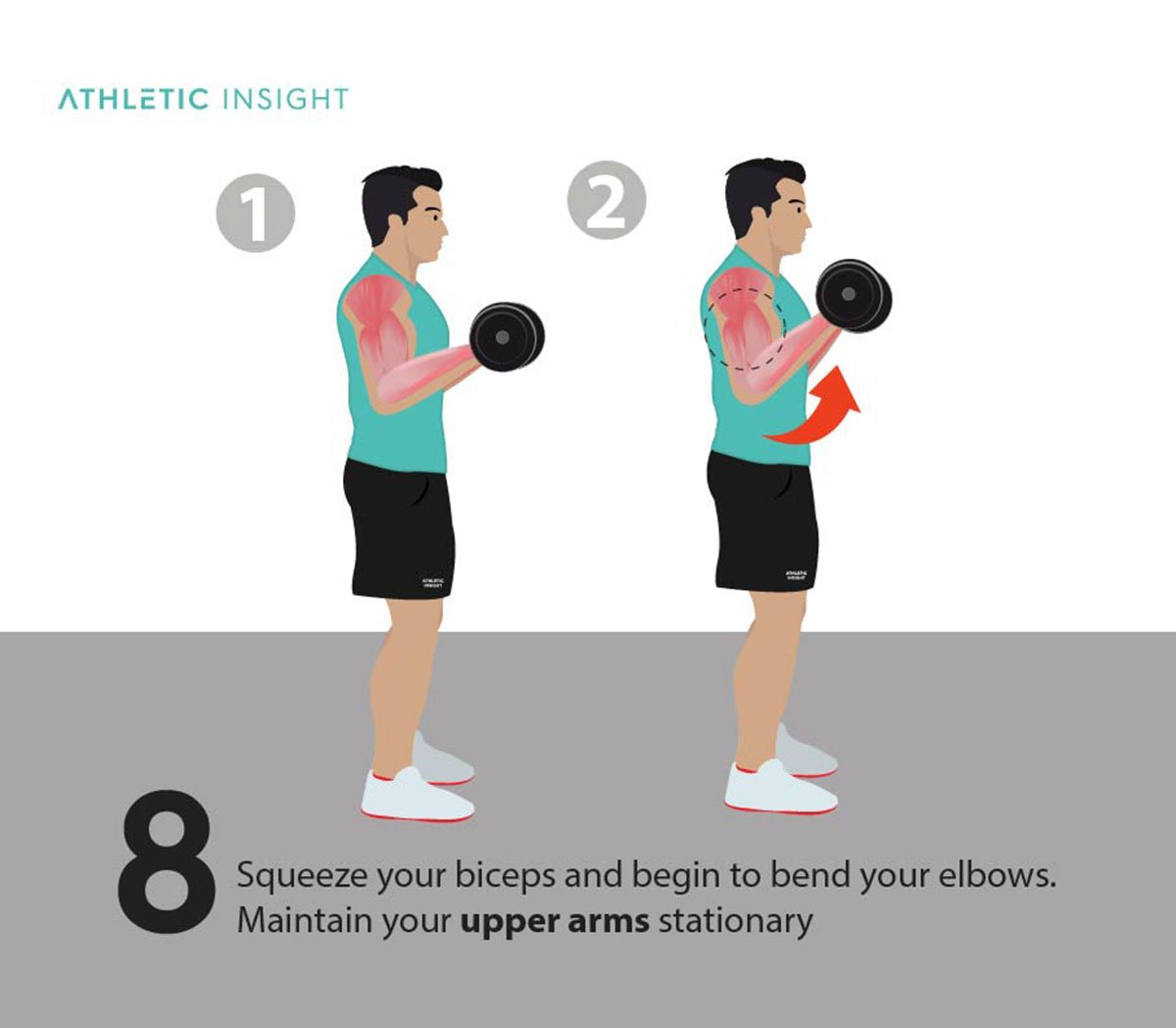
9. Bend elbows until the lower and upper arm touch
Bend elbows until the lower and upper arm touch. Once the under forearm area touches your biceps, you have completed the proper range of motion. Depending on the size of your biceps and range of motion, your dumbbell path may slightly differ.
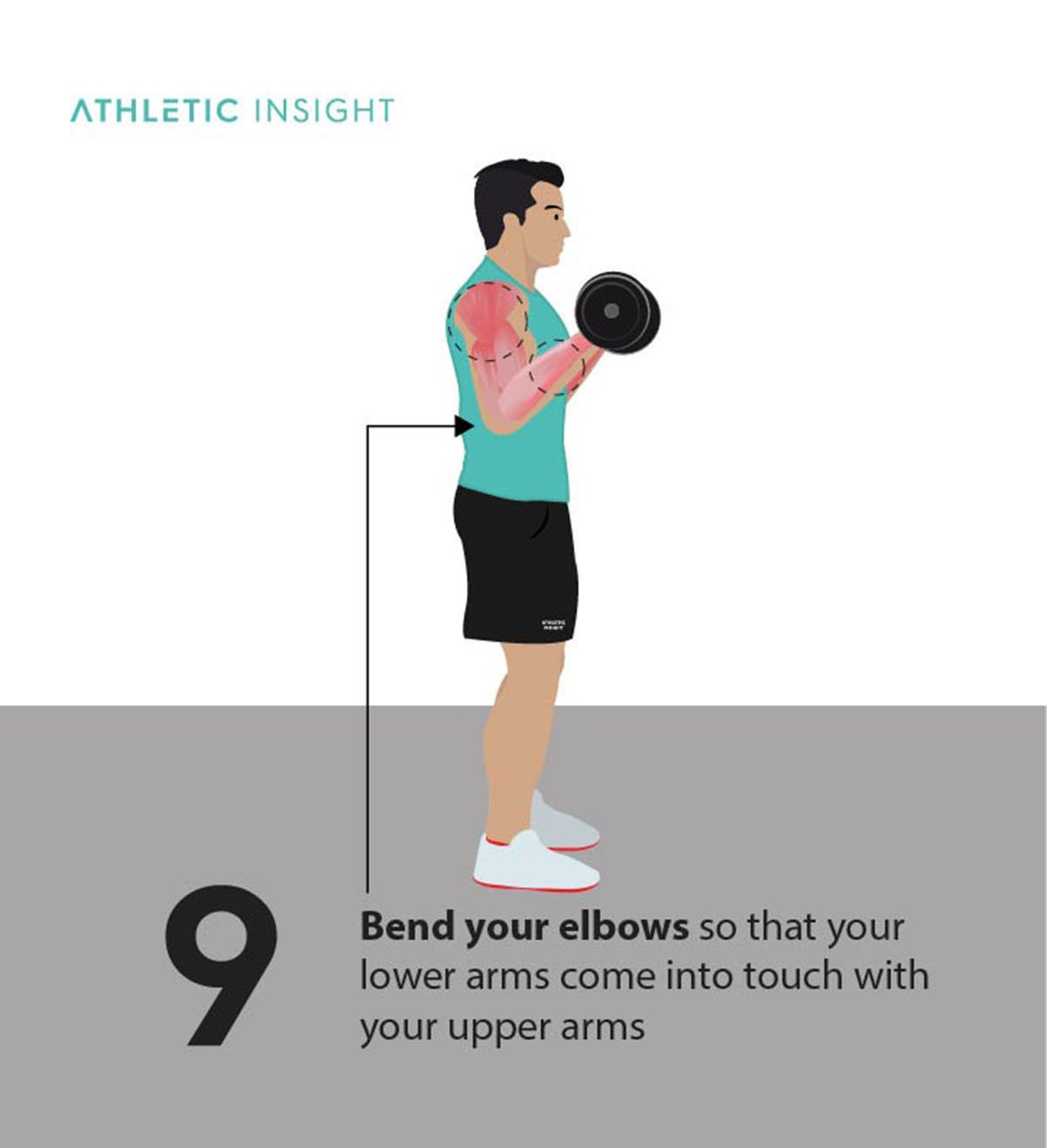
10. Squeeze biceps at the top (do not touch dumbbells to shoulders)
Like all exercises, you should consciously contract the muscle you are focusing on when possible. During the dumbbell curl, that means squeezing at the top of the movement, in between the concentric and eccentric portions. It is also important that you do not touch the dumbbells to your shoulders.
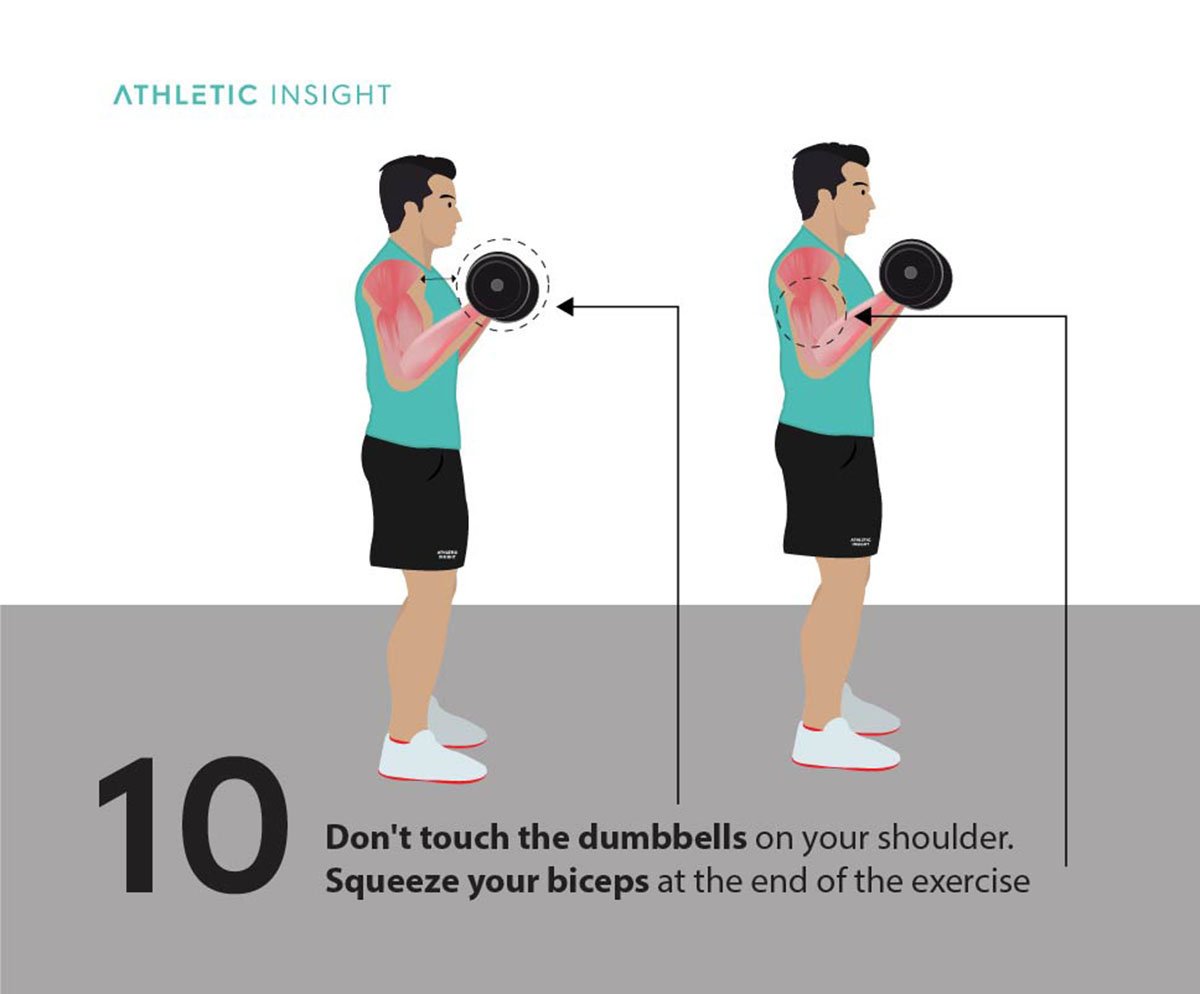
What Are the Benefits of Dumbbell Curl?
We’ll go into more detail below, but here’s a quick look at the benefits of a dumbbell curl.
- Gives you bigger biceps: These curls target both the long and short heads of the biceps brachii, which can make your biceps bigger, and give them that peak, horseshoe-shape that a lot of fitness enthusiasts strive for.
- Improves your elbow flexion: These curls activate the brachialis muscle, which is the most prominent muscle involved in elbow flexion and can have a significant impact on the functional movement of your elbows.
- Improves your grip strength: Another muscle activated by this exercise, the brachioradialis muscle in your forearm, is responsible for grip strength. While it’s an isolation exercise, you may notice that you’ve got a stronger grip when performing other exercises, like deadlifts, pull-ups, or bench presses.
What Are the Mistakes for Dumbbell Curl Form?
Despite being a simple exercise, it is possible to use an incorrect form. Here are some common dumbbell curl mistakes to avoid.
- Leaning forward or backward
- Moving your upper arms
- Letting your wrists turn
- Use momentum or swinging
1. Leaning forward or backward
When you lean, either way, it takes some tension off your biceps and can hurt your shoulders. To get the most out of this exercise, keep a long spine with a slight curve in the lower back.
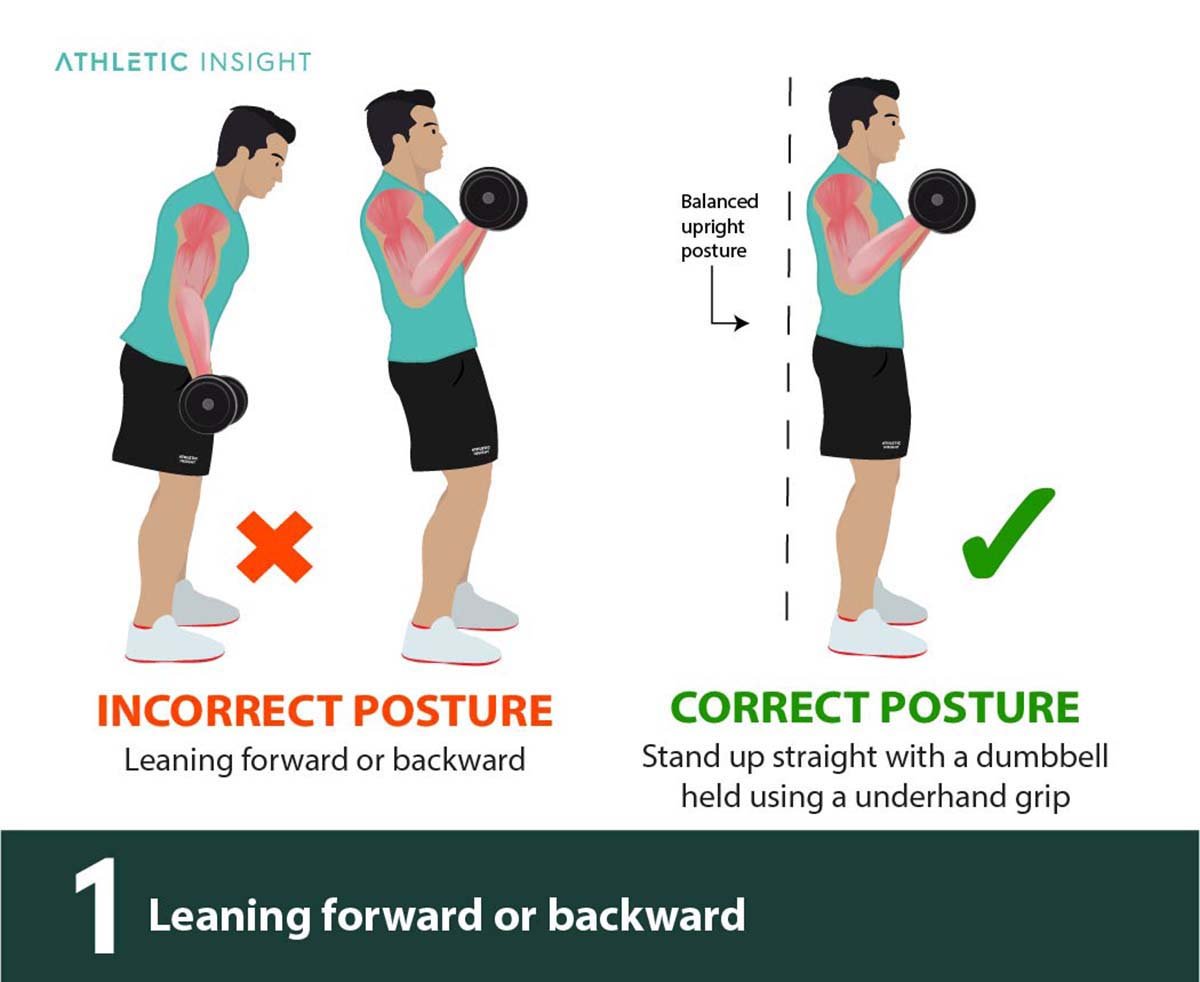
2. Moving your upper arms
By moving your upper arm, you take the tension off of your biceps. Instead, look for a motion that is referred to as “elbow flexion.” This motion brings your elbow towards the wrist. Do not bring them all the way up or down; maintain a range of motion while keeping your upper arms stationary.
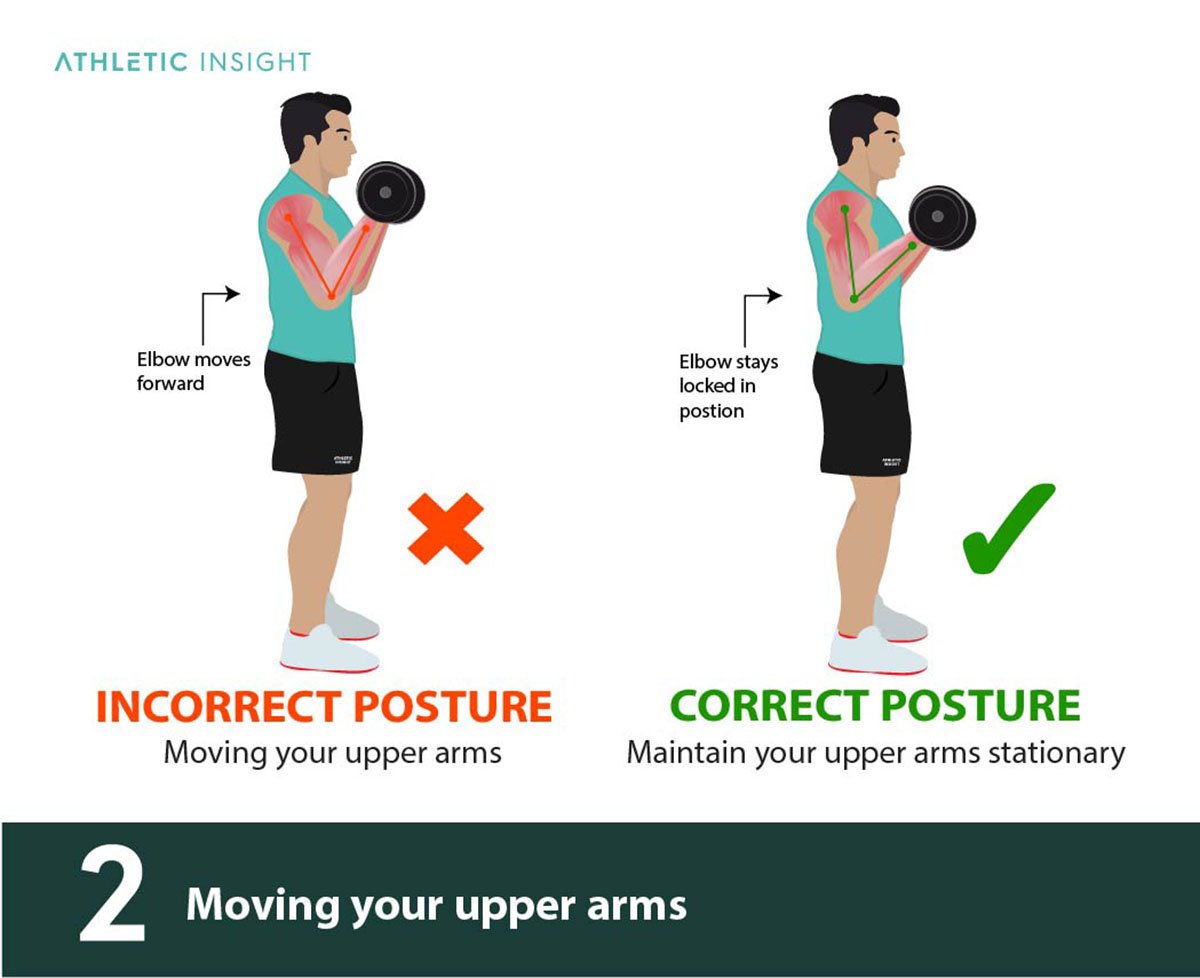
3. Letting your wrists turn
It will put tension on your forearm muscles instead of targeting the biceps in a good way. When you perform a Dumbbell Curl, make sure to keep your palms facing forward and resist turning your wrists at the wrong time during this exercise.
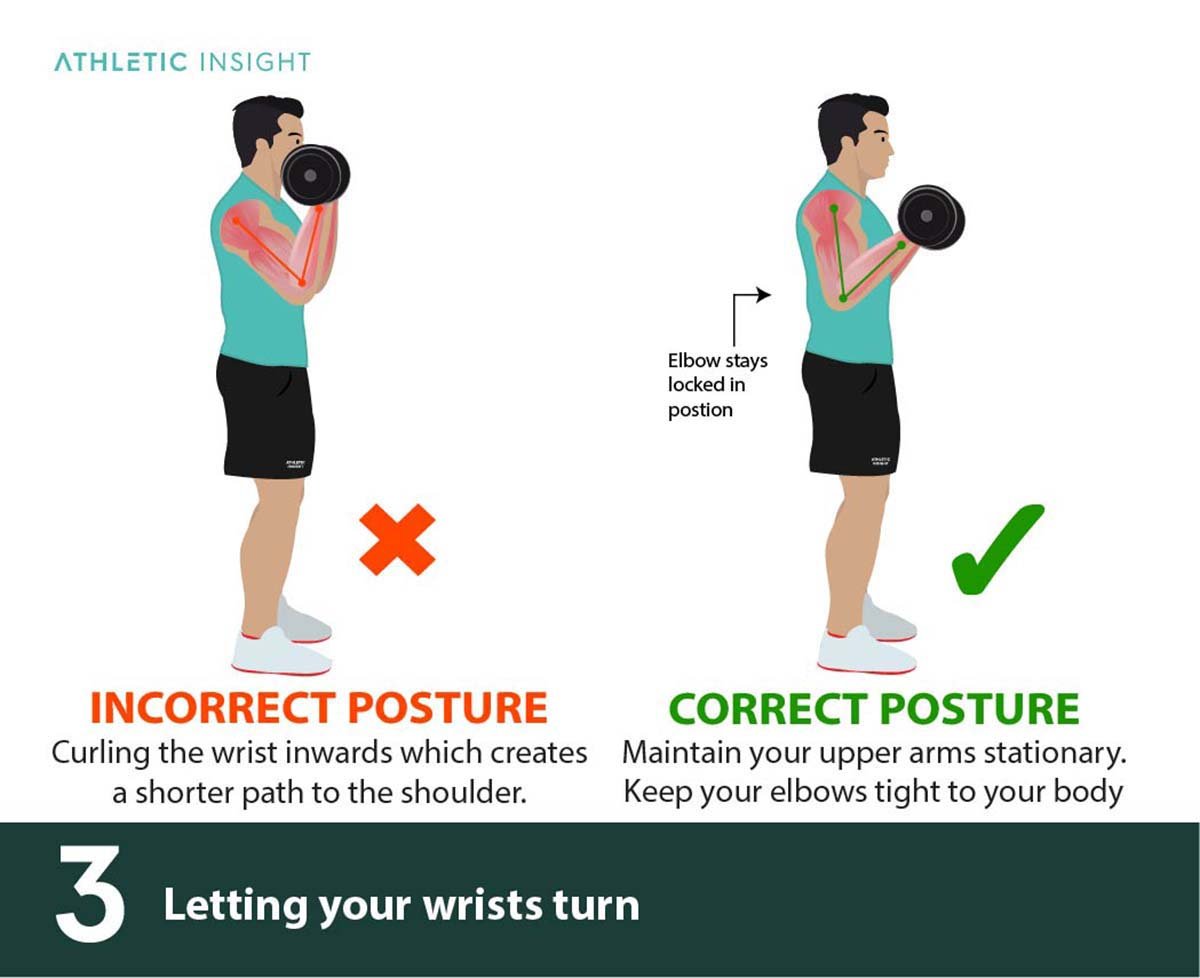
4. Use momentum or swinging
Using momentum only defeats the purpose of working on your biceps, and you risk getting injured. Swinging is not safe for your back, and it also takes the tension off your biceps.
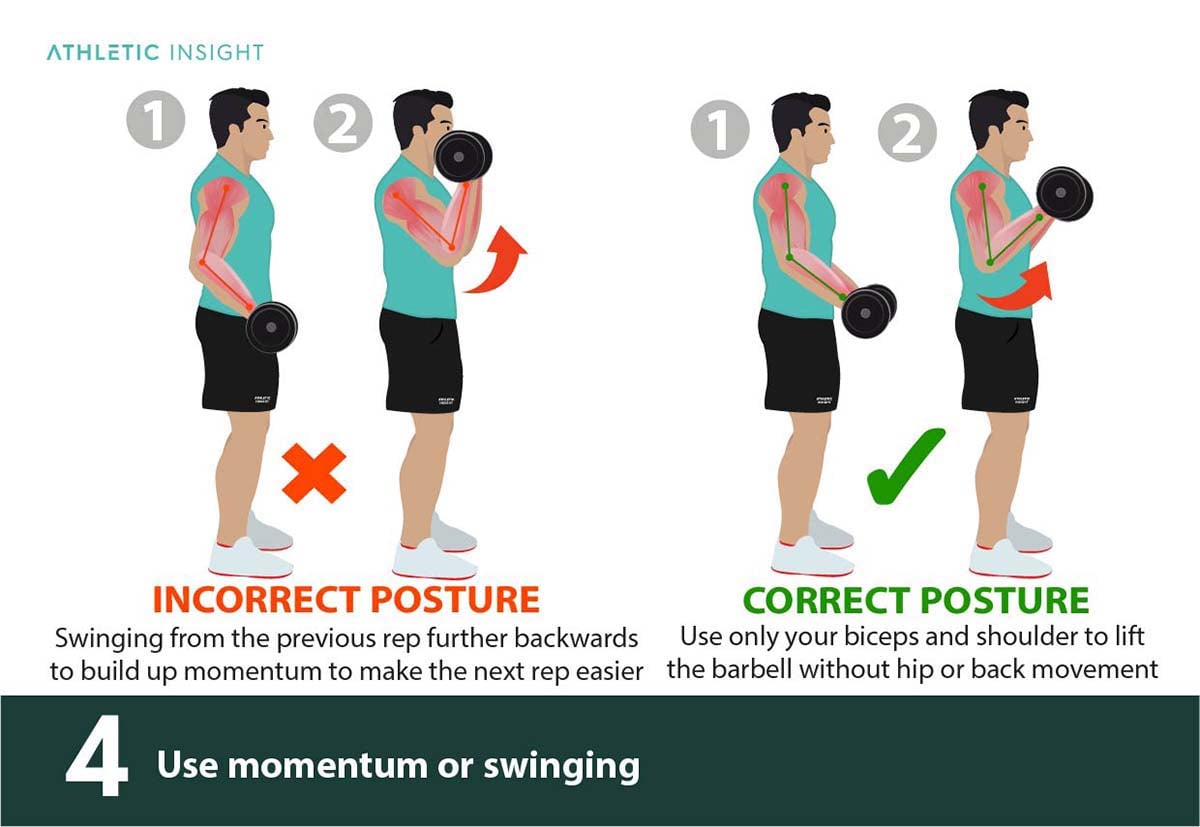
How To Determine Proper Weight for Dumbbell Curl?
The best way to find how much weight you should use is by testing yourself with different weights. You can do this by working up to a certain amount of weight or going based on your fitness level. Of course, one of the simplest ways to put an end to the mystery is by starting with much lighter weights and gradually working your way up.
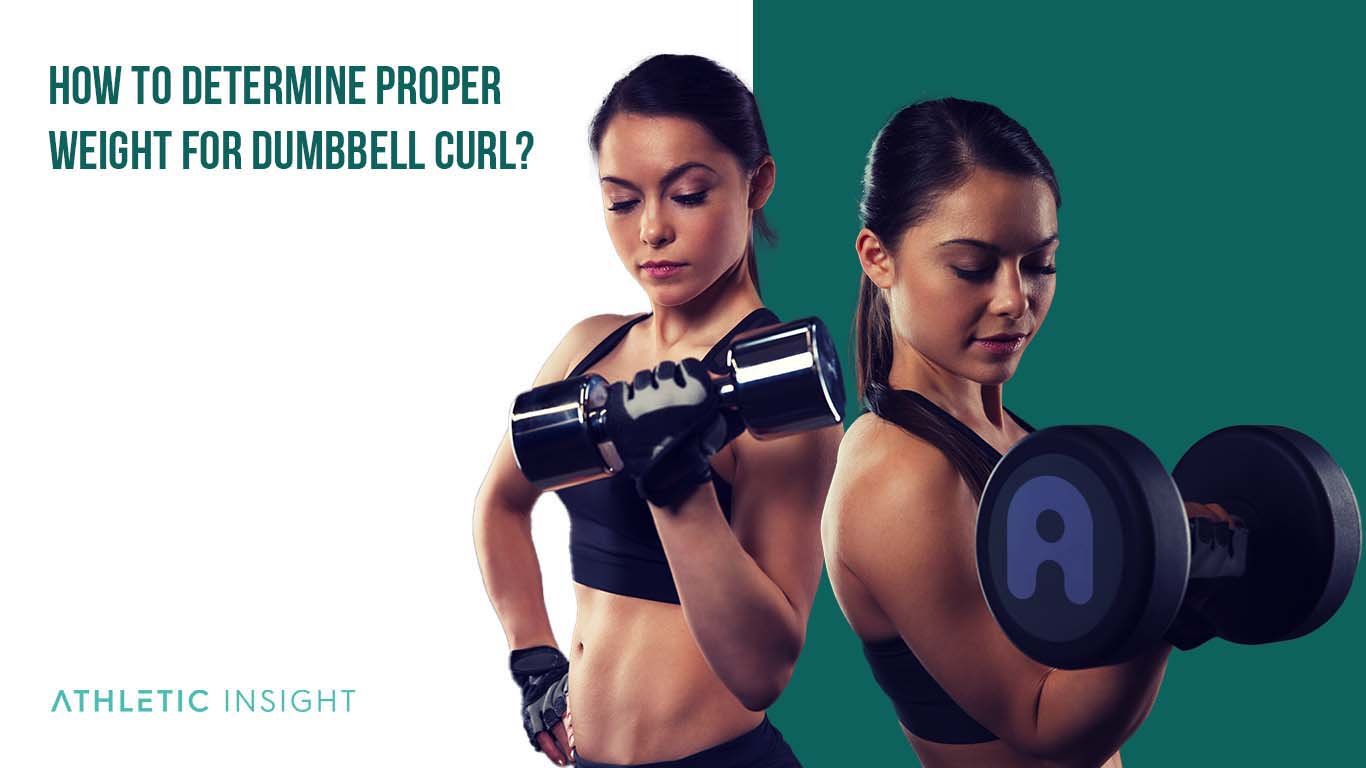
What Is the Importance of Grip for Dumbbell Curl?
A grip is a power or ability to hold something firmly with one’s hands. The ability to have a firm grasp of something is essential, especially when it comes to workouts and weight lifting. As you practice more and more, you will become better at it.
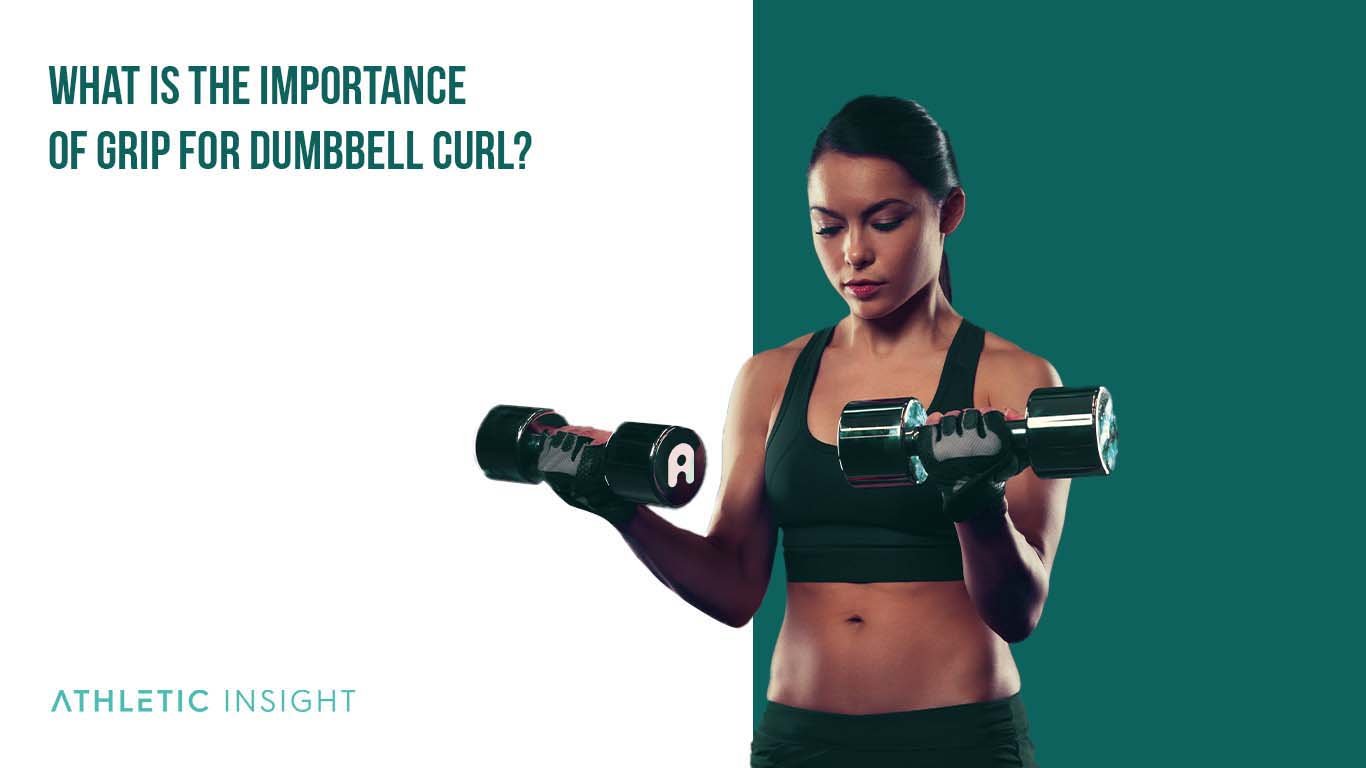
Why are Dumbbells Curved?
Dumbbells are curved to provide a better grip while working out. The curvature of the dumbbell makes it easier for your fingers to grasp and control the weight throughout your workout.
Which Muscles Are Involved While Performing Dumbbell Curl?
The primary muscles involved with dumbbell curls are the following.
- Biceps brachii
- Brachialis
- Brachioradialis
Secondary muscles worked are the Anterior Deltoid (front shoulder) and the Forearms (grip strength).
Dumbbell curls benefit the Biceps brachii by performing elbow flexion. As you curl the weight, the Biceps brachii effectively contracts and leads to the development of more muscle mass. And, as we’ve mentioned before, this can also lead to more functional elbow movement in your day-to-day life or future workouts as well.
The Brachialis and Brachioradialis are stabilizers and synergists of the biceps brachii. The anterior deltoid is one of the muscles that provide shoulder flexion; along with the coracobrachialis, they work together to provide a firm grip with lifting weights during curl movement.
What Are the Dumbbell Curl Variations?
There are many variations for curls, but not all of them target the biceps brachii muscle in the same way. For dumbbell curls, some workouts recommend starting with five reps and slowly working your way up to eight or even twelve reps.
1. Hammer curls
Conduct the hammer curl movement similar to a basic curl. However, the grip of the dumbbells will be facing each other instead of being perpendicular to each other.
The palms of your hands should also face inward while performing this exercise. Twist the wrists at the top of the movement.
2. Preacher curls
Perform the preacher curl variation of the Dumbbell Curl by sitting down on a preacher bench with an EZ curl bar in front of you. Your elbows are close to your body and should not move during the exercise. You should always keep your upper arms stationary while performing this exercise, as well as your palms.
3. Reverse curls
Use an EZ curl bar while sitting down on the bench to perform a reverse curl. Hands face away from you instead of towards your body while you lift the weight in front of you.
4. Incline dumbbell curls
The incline dumbbell curl is similar to a preacher curl, but your body weight will be resting on the incline bench with only the upper arms and elbow supporting you during this exercise. Hold a dumbbell in each hand at arm’s length. Curl the dumbbell until it reaches your shoulder. Lower the dumbbell back down and repeat as needed.
5. Concentration curl
Use an EZ curl bar and sit down on a bench with your knees bent and feet flat on the floor to perform a concentration curl. Lift one dumbbell, placing it under your biceps brachii, and resting your upper arm against your inner thigh for support.
What Is the Necessary Equipment for Dumbbell Curl?
The necessary equipment you’ll need for a Dumbbell Curl is dumbbells. In addition to standard dumbbells, you can do variations if you get an EZ curl bar, a preacher bench, and weight plates.
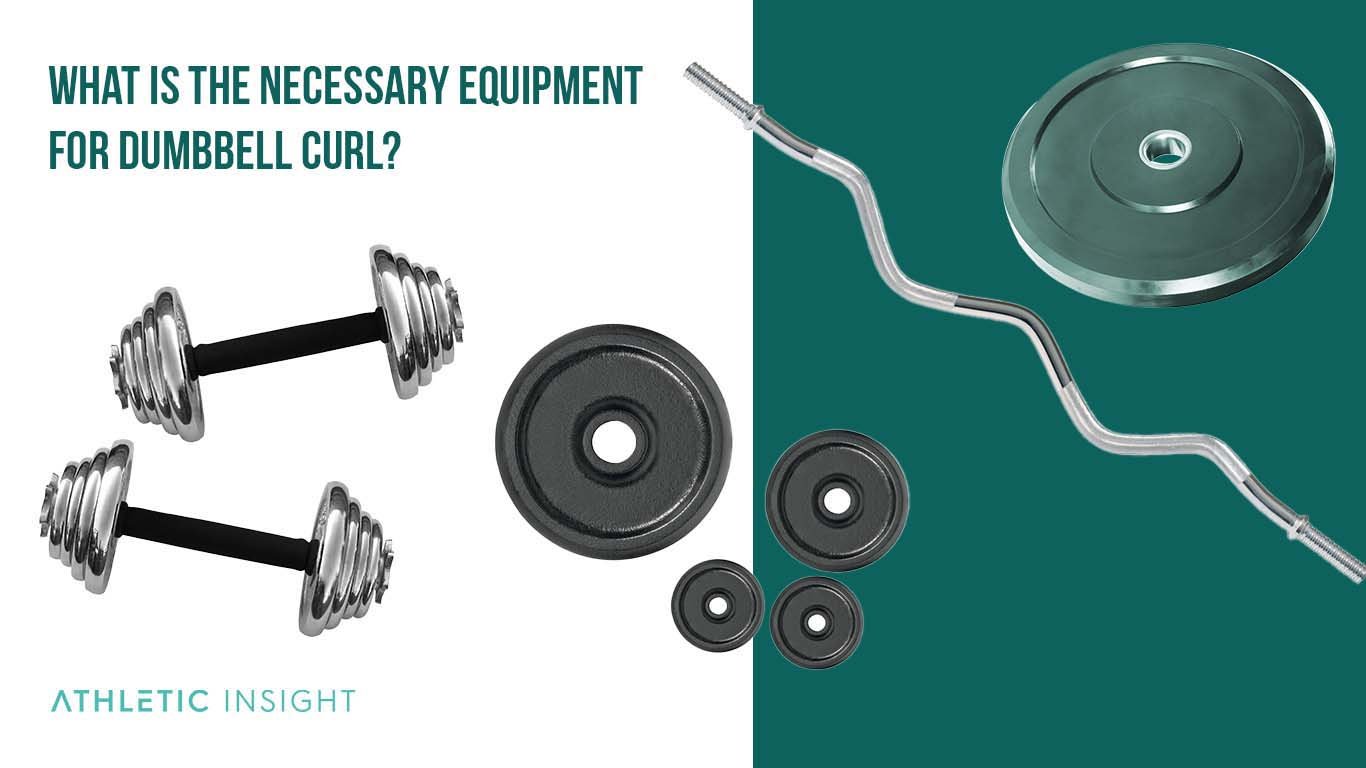
What Are Some Dumbbell Curl-Related Facts?
Make sure you warm up your muscles before performing the Dumbbell Curl. Warming up will not only make you feel better, but it can prevent injuries as well.
One to three sets of 12 to 20 repetitions can improve muscular endurance and growth.
You can do these exercises more frequently since you work a smaller muscle group (biceps brachii). And, to build up strength and endurance, you can also work with partial reps as well.
Is Dumbbell Curl practiced within CrossFit?
Yes, the dumbbell curl is practiced within CrossFit to aid the muscle development and muscle memory for performing various CrossFit related exercises. While the dumbbell curl is not an event competed in within CrossFit, the exercise is still actively utilized.
Is Dumbbell Curl a military movement?
No, the dumbbell curl is not a military movement. While the muscles engaged during the dumbbell curl may aid in the performance of actual military movements, alone, it is not a military movement that is performed.
Is Dumbbell Curl dangerous?
No, the dumbbell curl is not dangerous. While it is possible to strain a muscle or joint, it is uncommon to suffer an injury. While major injuries like bicep tears are possible, it is quite uncommon. The dumbbell curl is a safe movement to perform, especially when starting out.
Is Dumbbell Curl push or pull?
The dumbbell curl is a pull exercise. While it may appear that you are pressing or pushing the weight up at first, you are in fact, pulling.
Is Dumbbell Curl essential?
No, the dumbbell curl is not essential. While it is a common exercise, the dumbbell curl can be replaced with many variations and alternatives that exist to target the bicep. If you are going for hypertrophy, curl exercises may be required, but if strength is your goal, you can skip the bicep curl entirely for something like the barbell row.
Is Dumbbell Curl an olympic lift?
No, the dumbbell curl is not an Olympic lift. While dumbbell curls may help an Olympic athlete is many ways, the exercise is not practiced as a singular event.
Is Dumbbell Curl a compound exercise?
No, the dumbbell curl is not a compound exercise. If performed correctly, the bicep should be isolated. If incorrect form is used, or if an alternative form is preferred, other muscles may become involved which would make it a compound exercise.
What can replace Dumbbell Curl?
The dumbbell curl exists to develop the bicep, simple as that. For that reason, there are countless exercises that can replace the dumbbell curl, some of which are listed below.
- Hammer Curl
- Drag Curl
- Preacher Curl
- Cable Curl
- Concentration Curl
- Incline Curl
What is the difference of Dumbbell Curl and Bicep Curl?
Often, a dumbbell curl is referred to as a bicep curl, and visa versa. Technically speaking, a dumbbell curl is different from a bicep curl in that a dumbbell curl is only a type of bicep curl. A bicep curl can, however, can include a dumbbell curl, or a completely different exercise (cable curl, hammer curl, preacher curl, etc.).
What is the difference of Dumbbell Curl and Supinated Dumbbell Curl?
While the dumbbell curl is an isolation exercise that strictly targets the bicep, the supinated dumbbell curl targets the bicep and the forearm. Even though the forearm benefits from any type of curl, it is the supinated dumbbell curl that helps to expedite the growth of the forearm which is why the supinated bicep varieties are excellent to throw into the mix.
Is there a difference using a Barbell instead of a Dumbbell?
Yes, there is a difference when using a barbell instead of a dumbbell for dumbbell curls. While barbells may allow for more convenience if you don’t want to buy a bunch of free weights, when given the choice at a gym, stick with dumbbells. Dumbbells allow for a greater range of motion when performing the curl, allowing for better bicep development. Barbells limit your range of motion and can often cause wrist discomfort.

